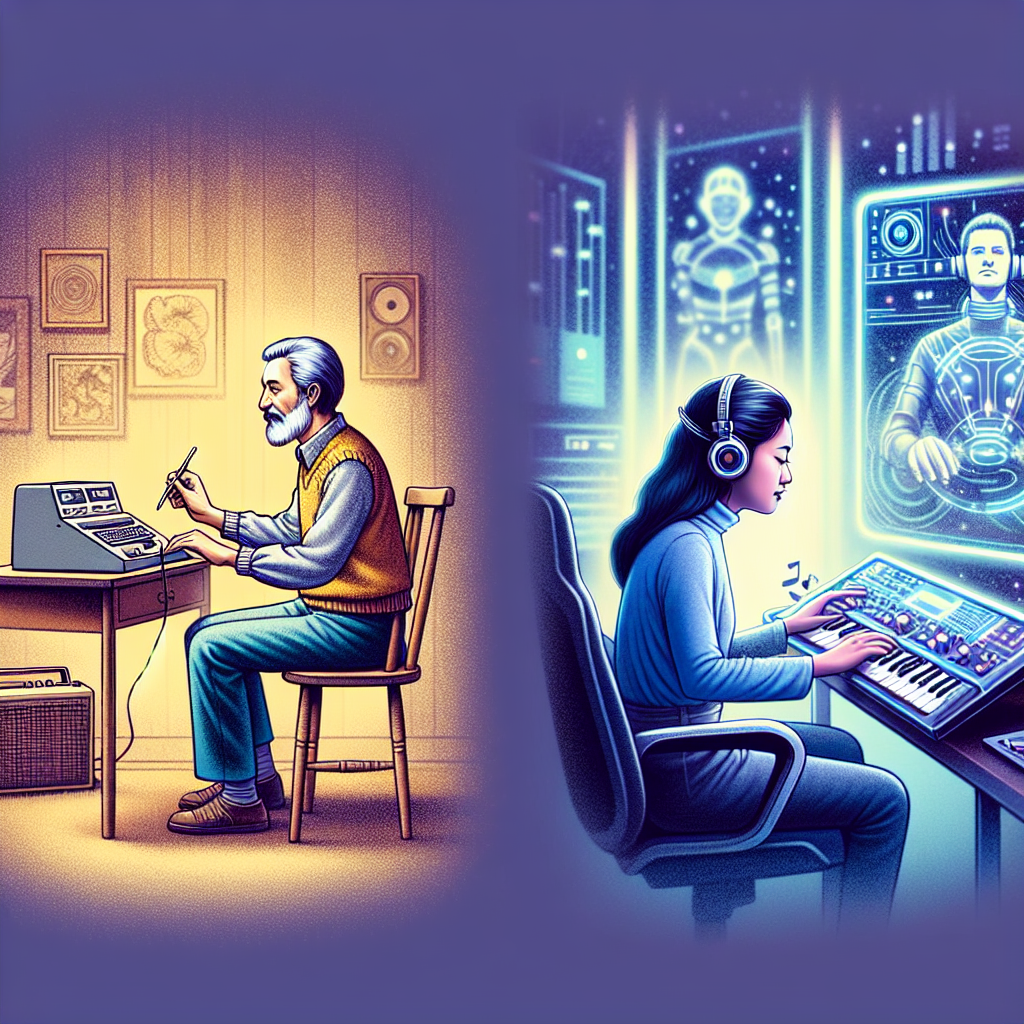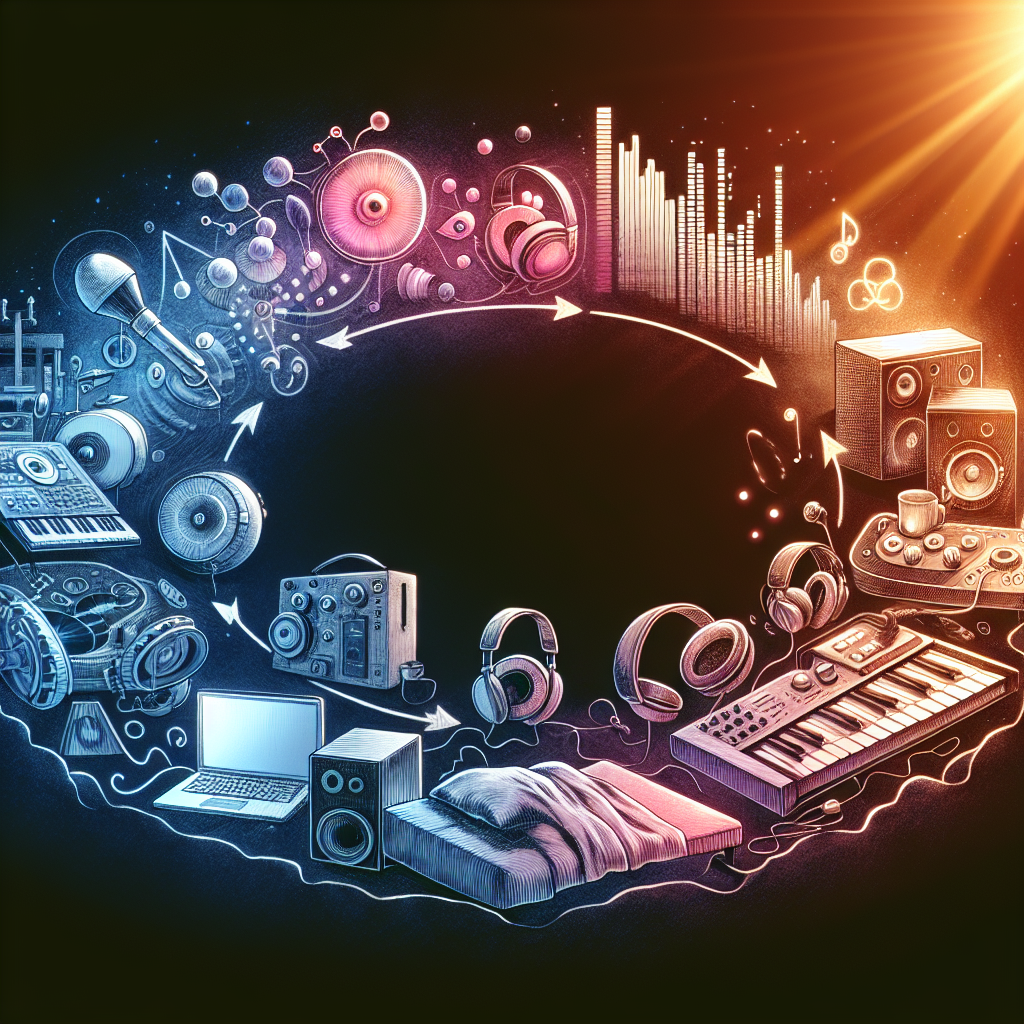The History of Lo-Fi Music: From Analog to Digital
Lo-fi music, also known as low-fidelity music, has been gaining popularity in recent years. It is a genre that is characterized by its raw and unpolished sound, often created by independent artists in their bedrooms. But where did this genre originate from? How has it evolved over the years? And what role do bedroom producers play in shaping its future?
To understand the history of lo-fi music, we must first go back to its roots. The term “lo-fi” was first used in the 1950s to describe recordings with a low quality sound, often due to technical limitations. These recordings were usually made on analog equipment, such as cassette tapes or vinyl records. This raw and unrefined sound was embraced by underground artists in the 1970s and 1980s, who saw it as a rebellion against the polished and commercialized music of the time.
As technology advanced, so did the production of music. The 1990s saw the rise of digital recording, which allowed for a cleaner and more polished sound. This led to a decline in the popularity of lo-fi music, as it was no longer seen as a rebellious or alternative genre. However, in the early 2000s, lo-fi music experienced a revival, thanks to the rise of the internet and the accessibility of digital recording equipment.
With the emergence of online platforms such as Bandcamp and Soundcloud, independent artists were able to share their music with a wider audience. This gave rise to a new wave of lo-fi music, created by bedroom producers who were able to experiment and create music in the comfort of their own homes. These artists were not bound by the limitations of traditional recording studios and were able to create music that was truly unique and authentic.
The rise of lo-fi music in the digital age also coincided with the rise of DIY culture. Bedroom producers were not only creating music, but they were also self-producing and self-releasing their work. This allowed for a more personal and intimate connection between the artist and their audience. Fans were able to support their favorite artists directly, without the interference of record labels or mainstream media.
The lo-fi music scene continued to grow and evolve, with artists incorporating elements from different genres such as hip-hop, jazz, and electronic music. This fusion of styles and influences gave birth to sub-genres such as chillhop, vaporwave, and lo-fi hip-hop. These sub-genres have gained a massive following, with millions of listeners tuning in to lo-fi music playlists on streaming platforms.
But what makes lo-fi music so appealing? Why are listeners drawn to its raw and unpolished sound? One reason could be its ability to evoke a sense of nostalgia. The crackling of vinyl records and the hiss of cassette tapes can transport listeners back to a simpler time. In a world where everything is constantly changing and evolving, lo-fi music offers a sense of comfort and familiarity.
Moreover, lo-fi music has become a form of self-expression for many bedroom producers. It allows them to create music that is true to their own unique style and vision, without the pressure of conforming to mainstream standards. This has led to a diverse and inclusive community of artists and listeners, who share a love for lo-fi music and its DIY ethos.
In conclusion, the history of lo-fi music is a testament to the power of independent artists and the impact of technology on the music industry. From its humble beginnings as a rebellion against commercialized music to its current status as a global phenomenon, lo-fi music has come a long way. And with the rise of bedroom producers, it is safe to say that the future of lo-fi music is in good hands. So let’s embrace the imperfections and keep the lo-fi spirit alive.
The Rise of Bedroom Producers in the Lo-Fi Scene

Lo-fi music has been around for decades, but it wasn’t until recent years that it gained mainstream popularity. This genre, characterized by its raw and unpolished sound, has captured the hearts of listeners all over the world. And at the forefront of this movement are the bedroom producers, who are shaping the future of lo-fi music.
So, who are these bedroom producers? They are independent artists who create music in the comfort of their own homes, using nothing but a laptop, a microphone, and their creativity. With the rise of technology and the accessibility of music production software, anyone with a passion for music can become a bedroom producer.
But what sets them apart from traditional producers? For one, they have complete creative control over their music. They don’t have to answer to record labels or follow any industry standards. This freedom allows them to experiment and push the boundaries of what is considered “good” music.
Another defining factor of bedroom producers is their DIY approach. They don’t have access to expensive recording studios or professional equipment, so they make do with what they have. This often results in a lo-fi sound, with imperfections and background noise adding to the charm of the music.
But why has the lo-fi scene become a breeding ground for bedroom producers? One reason could be the rise of social media and streaming platforms. These platforms have made it easier for independent artists to share their music with the world and gain a following without the backing of a record label.
Moreover, the lo-fi community is known for its supportive and collaborative nature. Many bedroom producers connect with each other online, sharing tips, techniques, and even collaborating on tracks. This sense of community has allowed the lo-fi scene to thrive and has given bedroom producers a platform to showcase their talent.
But it’s not just about the music for bedroom producers. It’s also about the aesthetic and the overall experience. Many lo-fi artists incorporate visuals, such as retro anime or nostalgic footage, into their music videos. This adds another layer to the listening experience and creates a unique brand for the artist.
The rise of bedroom producers in the lo-fi scene has also challenged the traditional music industry. With their DIY approach and ability to connect directly with their audience, they have disrupted the traditional model of signing with a record label. This has given artists more control over their careers and has opened up opportunities for independent musicians to make a living from their music.
But perhaps the most inspiring aspect of bedroom producers in the lo-fi scene is their dedication and passion for their craft. Many of these artists are self-taught and have spent countless hours honing their skills and perfecting their sound. They are not in it for fame or fortune; they simply love creating music and sharing it with the world.
In conclusion, the rise of bedroom producers in the lo-fi scene is a testament to the power of passion and creativity. These independent artists have carved out a space for themselves in the music industry and are shaping the future of lo-fi music. With their DIY approach, supportive community, and dedication to their craft, they are proving that you don’t need a fancy studio or a record label to make great music. So, if you have a love for music and a laptop, who knows, you could be the next bedroom producer to make waves in the lo-fi scene.
The Impact of Technology on the Evolution of Lo-Fi Music
Lo-fi music, also known as low-fidelity music, has been gaining popularity in recent years. This genre is characterized by its raw and unpolished sound, often created using low-quality equipment and techniques. But what many people don’t realize is that lo-fi music has been around for decades, and its evolution has been heavily influenced by technology.
In the early days of lo-fi music, artists would record their music on cassette tapes using basic recording equipment. This resulted in a sound that was far from perfect, but it had a certain charm to it. The imperfections in the recordings gave the music a unique and intimate feel, as if the listener was right there in the artist’s bedroom.
As technology advanced, so did the production of lo-fi music. With the introduction of digital recording software and equipment, artists were able to create lo-fi music with a higher level of quality. However, this also led to a debate within the lo-fi community about whether this new technology was taking away from the authenticity of the genre.
But as time went on, it became clear that technology was not hindering the evolution of lo-fi music, but rather enhancing it. With the rise of social media and streaming platforms, lo-fi music was able to reach a wider audience than ever before. Artists could now share their music with the world without the need for a record label or expensive equipment.
One of the most significant impacts of technology on lo-fi music has been the rise of bedroom producers. These are artists who create music in the comfort of their own homes, using nothing more than a laptop and a few pieces of equipment. This has opened up a whole new world of possibilities for aspiring musicians, as they no longer need access to a professional studio to create and share their music.
The rise of bedroom producers has also led to a more diverse and inclusive lo-fi community. With the barriers to entry lowered, artists from all backgrounds and walks of life are able to create and share their music. This has resulted in a melting pot of styles and influences, making lo-fi music more dynamic and exciting than ever before.
But perhaps the most significant impact of technology on the evolution of lo-fi music is the ability to collaborate and connect with other artists from around the world. With the click of a button, artists can now collaborate on tracks, share ideas, and support each other’s work. This has created a sense of community within the lo-fi genre, with artists coming together to push the boundaries and experiment with new sounds.
Technology has also played a crucial role in the production process of lo-fi music. With the use of digital effects and plugins, artists can now manipulate and distort their recordings to create a lo-fi sound without the need for expensive equipment. This has given artists more creative freedom and has allowed them to experiment with different sounds and techniques.
In conclusion, the impact of technology on the evolution of lo-fi music cannot be overstated. From the early days of recording on cassette tapes to the rise of bedroom producers and the use of digital effects, technology has played a significant role in shaping the genre. And as technology continues to advance, so too will the evolution of lo-fi music. So, to all the bedroom producers out there, keep pushing the boundaries and shaping the future of lo-fi music. The possibilities are endless, and the world is listening.




